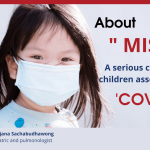"MIS-C" , a Serious Condition in Children Associated With COVID-19
“MIS-C”, and “Long COVID” are words commonly found in social media these days. It is a serious condition after children have recovered from COVID-19 infection. When they go on to develop MIS-C, different body parts and multiple organ systems become inflamed. Without quick and intensive treatments, children might be at greater risk of death.
Within 2-6 weeks after the children have recovered from COVID-19 infection, parents should be aware of MIS-C and monitor for indications of inflammation.
Symptoms of MIS-C

- Fever
- Irregular heartbeat
- Chest pain
- Difficulty in breathing
- Severe stomach pain
- Nausea and Vomiting
- Diarrhea
- Drowsiness
- Seizure
- Headache
- Skin rash
- Red eyes
- Swollen tongue
These signs and symptoms frequently appear at the same time. Parents should take their children to a physician straight away if their children display any of the symptoms listed above. A physician will treat the child to minimize inflammation. Children who receive quick and effective treatment have a lower chance of developing severe symptoms and are more likely to fully recover from this disease.
MIS-C - What Is It?
According to Dr. Anjana Sachabudhawong, MD, a pediatrician at Bangkok Hospital Chiang Mai, MIS-C is a group of indications or symptoms in which more than two organ systems become inflamed, potentially leading to organ failure.

Children usually develop MIS-C symptoms 2-6 weeks after recovering from COVID-19 infection. The cause of MIS-C is unknown at this time; however, it is thought to be linked to an overactive immune response to the COVID-19 virus.
The number of MIS-C cases has also grown, according to the pediatrician. The majority of incidents occur in youngsters aged 5 to 9.
According to statistics, one out of every 3,000–5,000 children infected with COVID-19 develops MIS-C, and 75 percent of these children were previously healthy. As a result, the severity of symptoms experienced when infected with COVID-19 has no bearing on the chance of contracting MIS-C.
According to a study, MIS-C was initially introduced from the United Kingdom in April of 2020. Following that, MIS-C cases were discovered in a number of countries, including Thailand.
How Is MIS-C Diagnosed?
A pediatrician may request that the children undergo the following clinical examination and laboratory tests in order to diagnose MIS-C:
- A blood test: is used to check for infection and inflammation in the body.
- An echocardiogram: is used to detect abnormal coronary artery conditions.
Suggestions for Parents
The best way to protect the children against MIS-C, according to Dr. Anjana, is to keep them away from COVID-19 infection.

If the children have COVID-19, however, parents must keep a close eye on them for two to six weeks after they recover. Parents must take their children to a physician for a clinical assessment and treatment if they notice any indications or symptoms.
Not all children infected with COVID-19 will acquire MIS-C. Parents, on the other hand, must exercise caution and ensure that their children receive proper care. Most significantly, keeping the children from being exposed to COVID-19 is the most effective way to prevent MIS-C in children.
Pediatric Specialty, Pediatric Center
Long COVID Center | Bangkok Hospital Chiang Mai








